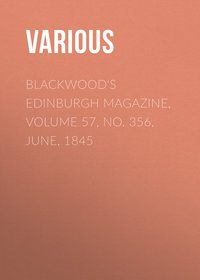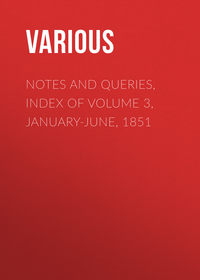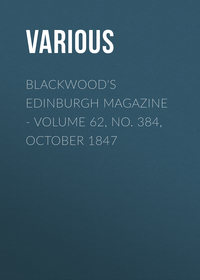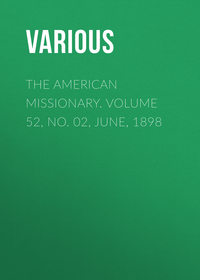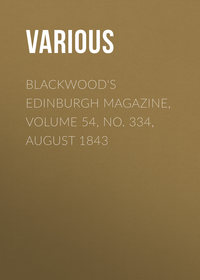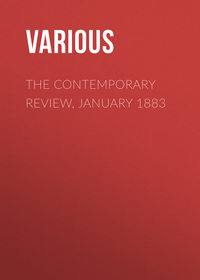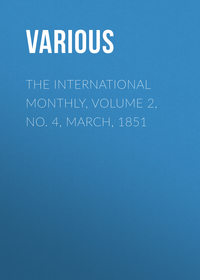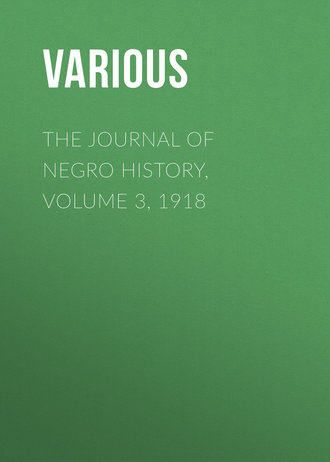 полная версия
полная версияThe Journal of Negro History, Volume 3, 1918
167
Maryland Historical Society Publications, I, 1844-48, I, p. 79.
168
A copy of Banneker's letter to Thomas Jefferson and the statesman's reply were published in the Journal of Negro History, III, p. 69.
169
Catholic World, XXXVIII, December, 1883.
170
Washington Star, October 15, 1916.
171
Georgetown Weekly Ledger, March 12, 1791.
172
Tyson, Banneker, p. 37.
173
Tyson, Banneker, pp. 70-71.
174
Tyson, Banneker, pp. 35-60.
175
Records of the Columbia Historical Society, XX, pp. 117-119.
176
The Atlantic Monthly, XI, p. 84.
177
Tyson, Banneker, p. 31.
178
Ibid., p. 31.
179
Catholic World, XVIII, p. 354.
180
Norris's Memoir, Maryland Historical Society Publications, II, p. 75.
181
Federal Gazette and Baltimore Daily Advertiser, October 28, 1806.
182
Norris's Memoir, Maryland Historical Society Publications, II, p. 64.
183
Ibid., II, p. 73.
184
Tyson, Banneker, p. 72.
185
Records of the Columbia Historical Society, XX, pp. 119-120.
186
He was sometimes called George Sharp.—See Benedict, History of the Baptists, etc., p. 189.
[187] The facts of this article for the most part are taken from letters written about the work of Liele and Bryan and from correspondence concerning them published in London in the Baptist Annual Register.
187
Mr. Moore was an ordained Baptist minister, of Brooke County, Georgia.
188
The Journal of Negro History, I, p. 71.
189
Under the influence of his preaching Liele's wife was converted and baptized at Brunton Land.
190
Ibid., p. 336.
191
The Baptist Annual Register, 1790-93, p. 334.
192
The Journal of Negro History, I, pp. 71-72.
193
The Journal of Negro History, I, p. 72.
194
The Baptist Annual Register, 1790-1793, p. 335.
195
Benedict, History of the Baptists, p. 189.
196
The Baptist Annual Register, 1798-1801, p. 368.
197
The Baptist Annual Register, 1798-1801, p. 366.
[199] Dow, History of the Cosmopolite, p. 124.
198
The Baptist Annual Register, 1790-1793, p. 339.
199
Dow, Experience and Travels, p. 125.
200
The Baptist Annual Register, 1790-1793, p. 340.
201
Ibid., 1798-1800, p. 367.
202
The Baptist Annual Register, 1798-1801, p. 368. Ibid., 1790-1793, p. 339.
203
Benedict, History of the Baptists, pp. 790-791.
204
The most easily available information concerning the history of Howard University is contained in a number of short sketches, speeches, reports, announcements, and the like, in pamphlet form, and a well-prepared volume of three hundred pages by Dr. Daniel S. Lamb giving the history of the Medical Department up to 1900. These with the files and annual catalogs have been freely used in the preparation of this sketch.
205
William M. Patton, The History of Howard University, 1896.
206
Woodson, The Education of the Negro Prior to 1861, p. 228.
207
Albert Bushnell Hart, The Southern South, pp. 289-291.
208
Probably the most famous of these early schools was the normal school for girls opened by Miss Myrtilla Miner, December 3, 1851, and chartered under the name "Institution for the Education of Colored Youth," under the Miner Board. In 1879 it was taken over by the public school system of the District as the Myrtilla Miner Normal School. From 1871 to 1876 it worked cooperatively with the Normal Department of Howard University.
209
Annual Report of the President of Howard University, September 2, 1869.
210
The relationship between the First Congregational Church and Howard University has been very close from the first. Three of its pastors have become presidents of the University, Doctors Rankin, Boynton and Newman. The church building at the corner of Tenth and G Streets has always been available for use for University exercises when needed. For many years the commencement exercises of various departments were held regularly in that auditorium.
211
Danforth B. Nichols, The Genesis of Howard University, 1892, p. 4.
212
Nichols, The Genesis of Howard University, 1892, pp. 5, 6.
213
Dean Robert Reyburn, Address at the Inauguration of President John Gordon, 1904, p. 9.
214
"Oliver Otis Howard, the founder of the University, and the one whose name it bears, and who was president from April 5, 1869, to December 1, 1873, was born in Leeds, Maine, November 8, 1830. He was graduated at Bowdoin, 1850, and at West Point in 1854. He was instructor in mathematics at West Point in 1854 and resigned in 1861 to take command of the Third Maine Regiment in the War of the Rebellion, in which he served with distinction. For gallantry at the first battle of Bull Run he was made Brigadier-General, September 3. He lost his arm at Fair Oaks, June 1, 1862, and was in the battle of Antietam. In November, 1863, he was made General of Volunteers. He commanded the Eleventh Corps under General Hooker, served at Chancellorsville, Gettysburg, Lookout Mountain and Missionary Ridge, and was assigned to the Army of the Tennessee. In the march to the sea he commanded the right wing of Sherman's army, and was brevetted Major-General in the regular army for gallant conduct in the campaign of Atlanta. He was Commissioner of the Freedmen's Bureau from March, 1865, to July, 1864, when he was assigned to the command of the Department of the Columbia. In 1877 he led the expedition against the Nez Perces Indians and in 1878 against the Bannocks and Piutes. In 1881-1882 he was Superintendent of the United States Military Academy at West Point. In 1886 he was commissioned Major-General in the regular army.
"In 1863 he was made A.M. by Bowdoin College, and LL.D. in 1865 by Watervelt College. The same degree was given him by Shurtliff College and Gettysburg University. He was made Chevalier of the Legion of Honor of France in 1884. He published war articles in the Century and some stories that are partly autobiographical; also Chief Joseph and the Life of Count Gasparin. In 1892 he was commander of the Department of the Atlantic, and the second in command of the United States Army. Major-General Howard died at Burlington, Vermont, October 26, 1909."—J. E. Rankin, Presidents of Howard University, pp. 11-12.
215
James B. Johnson, Address at the Twenty-fifth Anniversary of Howard University, 1892, p. 18.
216
William M. Patton, The History of Howard University, 1896, p. 30.
217
The tract as originally purchased may be approximately described as extending eastward to the Soldiers' Home grounds and including almost the entire present site of the reservoir (not including the extreme eastward projection) and running south on its eastern boundary to V Street. Its southern boundary was an irregular line passing south of the Medical School building and including a small part of the ground now occupied by the American League baseball park. Its northern boundary toward the east extended up to and at one point a little beyond what is now Hobart Street, tapering toward the west and meeting Georgia Avenue at Fairmount Street. The western, boundary followed Georgia Avenue to Howard Place, whence it followed Sixth Street to the southern boundary.
218
Daniel S. Lamb, Howard University Medical Department, 1900, p. 2.
219
This park was at one time surrendered to the Federal government for the remission of back taxes and exemption from further taxation. Later, when the new Freedmen's Hospital was about to be erected on that site the ground was transferred back to the University. The ground is now leased by the government from Howard University for a rental of one dollar a year.
220
William M. Patton, The History of Howard University, p. 17.
221
The Freedmen's Bureau was established in 1866 by the Federal government for the purpose of promoting the general welfare of the freedmen. General Howard was made commissioner of the organization and held this office until 1872, when it was discontinued. It was through this relation with the Freedmen's Bureau that the University became the creature and ward of the Federal Government, a relation that has been maintained continuously ever since.
The commissioner of the bureau was granted large powers, including the control of all subjects relating to refugees and freedmen from slave States or from any district or county within the territory embraced in the operations of the army, under such rules and regulations as might be prescribed by the head of the bureau and the President.
General Howard during the existence of the bureau disbursed approximately $13,000,000 in various ways. Much of this was used for educational purposes, including all grades of work. Among some of the beneficiaries of this fund were Lincoln University, Wilberforce University, Berea College, Fisk University, Biddle University, Straight University and Lincoln Institute. In his efforts to enable the people of the District of Columbia to share the benefits of this fund the commissioner offered to erect a building for a certain denominational institution located in Washington at that time, on the condition that it become undenominational. The offer was declined, whereupon the trustees of Howard University immediately made application to receive this Federal aid. Because of the location of the proposed institution at the nation's capital the application was favorably acted upon and liberal appropriations made so that the institution might stand as a monument to the nation's philanthropy.
As these large expenditures for Howard University with the other operations of the bureau brought upon General Howard charges of malfeasance, which led to two investigations, it should be said here that both of the official investigations, one civil, the other military, completely exonerated him.—See Report of Special Committee of the Trustees of Howard University upon Certain Charges, etc., 1873, and Act of March 3, 1865, establishing the Bureau of Refugees, Freedmen and Abandoned Lands.
222
It is worthy of note that the magnificent new home of the Myrtilla Miner Normal School of Washington is named in honor of the same noble woman. It stands on a site formerly owned by the University and looks upon Miner Hall several hundred yards away across the campus.
223
Much credit for the skillful financial management of the institution during these critical times is due to the secretary and treasurer, Mr. James B. Johnson, who was a potent factor in the early struggles of the institution. He was secretary and treasurer for many years, dying while still in service in 1898.
224
William M. Patton, The History of Howard University, 1896, pp. 21, 22.
225
Mag. of Am. History, XVIII, 424.
226
Boutwell, Report, 1446, 1470.
227
Ibid., 608.
228
These letters are taken from E. B. Washburne's Sketch of Edward Coles, Second Governor of Illinois, and of the Slavery Struggle of 1823-1824.
229
Ibid., p. 18.
230
Jefferson's reply was published in The Journal Op Negro History, Vol. III, p. 83.
231
The last paragraph of Mr. Birkbeck's letter cannot but excite admiration. The quotation from Horace applied with great force to the case of Governor Coles:
"Neither the ardor of citizens ordering base things, nor the face of the threatening tyrant shakes a man just and tenacious of principle from his firm intentions."
232
Hening's Statutes, Vol. X, p. 50.
233
Hening's Statutes, Vol. XI, p. 309; Treat, P. J., National Land System, p. 235.
234
Ibid., Vol. X, pp. 35-45.
235
Winterbotham, An Historical Geographical Commercial and Topographical View of the United States, Vol. 3, pp. 156-157.
236
Kentucky Land Grants, Book 13, p. 59.
237
Ibid., Book 8, p. 228.
238
Shaler's Autobiography, p. 33.
239
Michaux (Thwaite's Reprint), Travels to the West of the Allegheny Mountains, Vol. 3, p. 237.
240
Shaler, N. S., Kentucky, p. 196.
241
Greeley, Horace, Writings, Speeches and Addresses of Cassius M. Clay, p. 177.
242
Collected Documents, 1847, p. 581.
243
Stowe, Key to Uncle Tom's Cabin, p. 143.
244
Louisville Weekly Journal, October 17, 1849.
245
Shaler's Autobiography, p. 36.
246
Louisville Public Advertiser, December 24, 1829.
247
Lexington Observer and Kentucky Reporter, February 27, 1834.
248
Louisville Weekly Journal, March 4, 1846.
249
Louisville Weekly Journal, September 3, 1845.
250
Lexington Observer and Kentucky Reporter, Jan. 28, 1835.
251
Ibid., July 9, 1834.
252
Lexington Observer and Kentucky Reporter, Jan. 7, 1835.
253
Louisville Weekly Journal, August 6, 1845.
254
Bairdstown Candid Review, June 20, 1809.
255
Louisville Weekly Journal, May 2, 1849.
256
Louisville Weekly Journal, September 26, 1849.
257
Lexington Western Luminary, June 5, 1833.
258
Blanchard and Rice, Debates on Slavery, p. 133.
259
Louisville Weekly Journal, July 30, 1845.
260
Ibid., July 19, 1848.
261
Ibid., August 14, 1850.
262
Ibid., August 2, 1848.
263
St. Louis Daily Times, October 14, 1852.
264
Louisville Daily Journal, November 23, 1848.
265
Louisville Public Advertiser, November 2, 1825.
266
Ibid., September 13, 1826.
267
Louisville Daily Times, March 1, 1854.
268
Slavery and Internal Slave Trade in the U. S., p. 12.
269
Martin, Asa E., Anti-Slavery Movement in Kentucky, p. 89.
270
Collins, History of Kentucky, Vol. 1, p. 74.
271
Henderson Weekly Commercial, January 29, 1858.
272
Georgetown Gazette, December 23, 1858.
273
Weekly Free South (Newport), April 29, 1859.
274
Debates of the Convention of 1849, p. 73.
275
Little, L. P., Ben Hardin, his Times and Contemporaries, p. 544.
276
Presbyterian Herald, April 12, 1849.
277
Collected Documents, 1847, pp. 581-583; 1853, pp. 401-403; 1860, pp. 241-246.
278
Littell's Laws, 1: 32.
279
Brown, John Mason, The Political Beginnings of Kentucky, p. 229.
280
Littell's Laws, 1: 44.
281
Ibid., 1: 161.
282
Littell's Laws, 2: 113.
283
Littell's Laws, 2: 114.
284
Littell's Laws, 2: 116-117.
285
Littell's Laws, 2: 117-118.
286
Littell's Laws, 3: 403.
287
Ibid., 2: 117-118.
288
Niles' Register, February 2, 1830.
289
Littell's Laws, 4: 223-224.
290
Stroud, Laws relating to Slavery, p. 86. Littell & Swigert, 2: 1066-9; 1060-4.
291
It would perhaps be well to point out here the general common-law difference between the treatment of real and personal estate in a will. The title of the personal property of the deceased is vested in the executor and he holds it for the payment of debts and distribution according to the will of the testator. On the other hand the real estate vests in the devisees or heirs and does not go to the administrator, unless by statute enactment, which was in part true in Kentucky, in the case above, where the slaves, although real estate, were held liable for the debts of their master. Littell's Laws, 2: 120.
292
T. B. Monroe's Report I., 23.
293
Beatty vs. Judy, 1 Dana, 101. Plumpton vs. Cook, 2 A. K. Marshall, 450.
294
Rothert, History of Muhlenburg County, p. 343.
295
Young, B. H., History of Jessamine County, p. 89.
296
Session Laws, 1834, p. 726.
297
Ibid., 1850, p. 51.
298
Ibid., 1856, Vol. 1, pp. 42-44.
299
Ibid., 1858, Vol. 1, pp. 47-48.
300
Starling, p. 290.
301
Littell's Laws, 1: 32.
302
Littell's Laws, 2: 119.
303
Ibid., 5: 293.
304
Ibid., 5: 435-437.
305
Barre, W. L., Speeches and Writings of Thomas F. Marshall, p. 115.
306
Section 1 of the law 1833 read: "Each and every person or persons who shall hereafter import into this state any slave or slaves, or who shall sell or buy, or contract for the sale or purchase, for a longer term than one year, of the service of any such slave or slaves, knowing the same to have been imported, shall forfeit and pay $600 for each slave so imported, sold, or bought, or whose service has been so contracted for; recoverable by indictment of a grand jury or any action of debt, in the name of the Commonwealth in any circuit court, where the offenders may be found." Session Laws, 1833, pp. 258-261.
307
Barre, W. L., p. 116.
308
Niles' Register, January 23, 1841.
309
Collins, Vol. 1, p. 83.
310
Session Laws, 1860, Vol. 1, p. 104.
311
Ibid., 1864, pp. 70-72.
312
Littell's Laws, 2: 5-6.
313
Ibid., 2: 5-6.
314
Session Laws, 1835, pp. 82-83.
315
Ibid., 1838, p. 158.
316
Session Laws, 1823, p. 178.
317
Ibid., 1831-2, pp. 54-55.
318
Session Laws, 1838, p. 155.
319
Ibid., 1830, pp. 173-175.
320
Western Law Journal, 2: 232-235 (best report of the trial). Niles' Register, December 21, 1844. Webster; Delia A., Kentucky Jurisprudence, pp. 1-84.
321
Fairbank, How the Way was Prepared, pp. 53, 57.
322
Ibid., p. 85.
323
Ibid., p. 103.
324
Fairbank, pp. 144, 149.
325
American Anti-slavery Society Report, 1839, p. 90.
326
American Anti-slavery Society Report, 1839, pp. 93-94.
327
Chaddock, F. E., Ohio before 1850, p. 86.
328
McMaster, History of the United States, Vol. 7: 262-263.
329
Senate Document No. 19, 30th Congress, 1st Session.
330
5 Howard's Reports, 215-232.
331
Colton, Reed and McKinley, Works of Henry Clay, Vol. 3: 329.
332
24 Howard's Reports, 109-110.
333
Littell's Laws, 2: 246-247.
334
Session Laws, 1823, p. 563.
335
Black vs. Meaux, 4 Dana, 189.
336
Susan vs. Ladd, 6 Dana, 30




